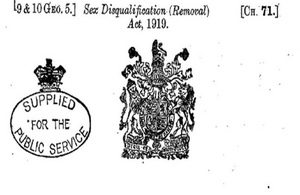
It was 100 years ago, on 23 December that the Sex Disqualification (Removal) Act 1919 was given royal assent. The Act is only 4 pages long, but marked a significant step forward for women's professional lives, permitting them to become lawyers and civil servants.
Most of the work of the Act is achieved by section 1, which provides that:
A person shall not be disqualified by sex or marriage from the exercise of any public function, or from being appointed to or holding any civil or judicial office or post, or from entering or assuming or carrying on any civil profession or vocation, or for admission to any incorporated society (whether incorporated by Royal Charter or otherwise), and a person shall not be exempted by sex or marriage from the liability to serve as a juror".
Previously being a woman or being married, prevented a woman from being appointed to or holding a wide range of professions. Section 1 also gave the power to make regulations and rules about the admission of women to the Civil Service, and the control the ability of women to be jurors.
Section 2 contained the specific entitlement for women to be admitted and enrolled as solicitors (on the proviso that they'd had the same legal education as men).
Section 3 provided that universities were not precluded by their charters or statutes from regulating the admission of women to membership of the university or obtaining a degree.
Section 4 provided that certain acts (listed in the Schedule) and other statutory provisions or royal charters which were inconsistent with the Act would cease to have effect.
The Act was short, but had profound effects on the abilities of women to participate fully in society, building on the Representation of the People Act 1918, which had given some women the right to vote.
The rights given by the Act were used almost immediate. Mrs Ada Summers, the Mayor of Stalybridge was the first woman magistrate, being sworn in on 31 December 1919. She was a magistrate by virtue of her office as Mayor, and, because of this Act was probably the first woman to adjudicate in court. Ada was an active suffragist, using her wealth and position to support a number of schemes designed to improve conditions in Stalybridge, including a maternity and child welfare clinic, and clinics for the sick and poor.
Unfortunately, the wide-ranging powers of the Act didn't provide an immediate change in all spheres of life for women. In 1925, women could be recruited directly into the Administrative Class (higher policy-making grades) of the Home Civil Service, but the Tomlin Report found in 1931 that most departments employed no women in responsible posts. The Ministry of Defence only employed women as typists and women in the Post Office (then part of the Civil Service) were exclusively in a separate, worse paid, Women's Branch. Most significantly, women still had to resign when they married. That bar was not abolished until October 1946 for the Home Civil Service and 1973 for the Foreign Office. Women's pay scales were also lower than men's until 1961.
The rights of some women to vote (the centenary of which we celebrated last year), and the rights of women to become civil servants and lawyers, which we're celebrating this year, marked fundamental stepping stones towards building the society, and the GLD, we see today.






